Plant Exploring in Yunnan, China, 2005
Dalen Bayes, Lori Bayes, Mary Berg, Loretta Goetsch, Steve Hootman, Glen Jamieson, Brenda Macdonald, Bill McMillan, Sonja Nelson, Sean Rafferty, Garratt Richardson, Jeanine Smith, Garth Wedemire, Keith White
Introduction
Sonja Nelson
Seventeen of us from British Columbia, Washington and Oregon traveled to northwestern Yunnan Province, China, in May 2005 to see how the rhododendrons we knew intimately in our gardens grew in the wild in their Asian homeland. All in all, we saw approximately seventy-five
Rhododendron
species. For some of us it was our first ever trip to Asia. For others, it was a return to China to experience once again the excitement of new finds. For all, it was an unforgettable adventure in a botanical wonderland.
Northwest Yunnan is one of the richest temperate regions in the world for biodiversity. Forty million years ago tectonic forces began the uplift of what is now the Hengduan Shan in Yunnan along with the Himalayas to the west and continue to this day. As a result, heavy rains drench the mountains, and rivers carry the glacier- and monsoon-fed rivers through deep gorges isolated from one another, including the three great rivers of China, the Yangtze (Jinsha Jiang), the Mekong (Lacang Jiang) and the Salween (Nu Jiang). Both the climate and topography foster the creation of new species of
Rhododendron
and other plant genera. No wonder the group found more than enough to satisfy their botanical curiosity!
The 20-day trip was sponsored by the Rhododendron Species Foundation in Federal Way, Washington. Steve Hootman, co-director of the Foundation, was our enthusiastic and able leader. Our host in China was the Kunming Botanical Institute. Two botanists from the Institute accompanied us and were our interpreters. Three drivers took us up the rough, narrow mountain roads and brought us safely down again. In the end, we had bonded into one tight group.
At the end of each day, we voted for a Plant of the Day and, at the end of the trip, a Plant of the Trip. Below you will find our choices described by members of the group.
Itinerary
The group met on May 13 in Kunming, the capital of Yunnan Province. In Kunming we visited the Kunming Botanical Institute and the Golden Temple. From Kunming we flew north to Lijiang, a part of which has been restored to an ancient Chinese town except that the main streets were mostly tourist shops. We made our first botanical foray in the Jade Dragon Snow Mountain region near Lijiang. From Lijiang we drove to the Laojun Shan lodge and spent a cold night at 13,775 feet (4200m). We then drove to Dali situated near Erhai Lake with the granite peaks of the Cang Shan range rising behind it. We spent a day botanizing on the Cang Shan and then headed west, crossed the Mekong and arrived in Liuku on the Salween. Our only rainy day was spent at the Hpimaw Pass near the Myanmar (Burma) border. We then proceeded further north along the Salween River to the town of Fugong. From Fugong we headed west up to the Yaping pass in the Gaoligong Shan, a tortuous drive that yielded many botanical finds. We then drove to Gongshan, our northernmost overnight stop on the Salween. From here we explored a tributary of the Salween, visited the Stone Gate at Bing Zhong Luo and attempted the Dulong pass but were stopped by snow. A long drive south took us away from the Salween and to Caojian. From here we drove up into the Ziben Shan to find marvelous drifts of
Rhododendron calostrotum
in full bloom. Our last botanical stop was at the Gaoligong Shan National Nature Reserve near Baoshan but, alas, a landslide prevented us from gaining the altitude for temperate climate plants, although we did find several interesting subtropical plants. On May 30 we were back in Kunming.
Acknowledgements
We are grateful to our host Guan Kaiyun of the Kunming Botanical Institute; two botanists from the Institute, Wang Zhong-lang and Wang Li-song, and our three drivers, Sun Wen-ke, Yang Wen-bin and Hui Hong, all of whom contributed immensely to our enjoyment of Yunnan.
Manglietia insignis
: Plant of the Day, May 14
Sean Rafferty
The lunch served following a morning tour of the gardens of our hosts at the Kunming Institute of Botany included lily bulbs stuffed with ground pork,
Smilacina
with noodles in broth, wild mushrooms, roasted lichens and (dare one utter?) sauted
Rhododendron decorum
flowers. These gastronomic botanical delights served both as lunch and as a template for many of our meals throughout the next three weeks in the mountains and valleys of Yunnan. The lunch had provided, as did most subsequent meals, instruction on local flora and fauna available as provender and a pleasant interlude to the tour of the gardens.
Afterwards, Guan Kaiyun, the Garden Director, continued leading the group on a tour of the Institute's outstanding gardens, proudly displaying exotic ferns, Jacaranda trees, begonias, bananas and rhododendrons. Even the North American invasive escapee,
Opuntia
, was showing its best form. However it was while Guan was showing the gorgeous magnolia collection that
Manglietia insignis
beckoned from behind the cover of a
Magnolia delavayi
. The
Manglietia
was approximately 12 feet (4m) tall with lovely, tidy, long and glossy green leaves of approximately 8-9 inches (20-23cm). While not blooming profusely, the combination of white, fragrant inner blossom and red outer petals of the 3-4 inch (8-10cm) wide flowers certainly held my attention. While I have seen
M. insignis
in cultivation before, this was my first viewing of it in bloom. This is a superb tree and impresses as being more than the sum of its parts. Despite the challenging display of plant material nearby, on this particular day
Manglietia insignis
could claim its victory as Plant of the Day.
Manglietia insignis
(the red lotus tree) is an evergreen member of the taxonomically challenging family Magnoliaceae, which also includes among others, the genera
Magnolia
,
Michelia
, and
Liriodendron
, and is a tree that should be grown more often. All that is required is a humus-rich, mildly acidic soil in full sun to partial shade, and a bit of room to climb to 30-40 feet (9-12m) in height and 15 feet (4.5m) in width. A large footprint, but well worth the effort.

|
|
Manglietia insignis
: Plant of the Day, May 14.
Photo by Sean Rafferty |
Cypripedium macranthum
: Plant of the Day, May 16
Keith White
Our first day in the field was May 16th. We rolled out early from ancient Lijiang towards Jade Dragon Snow Mountain. As we disembarked for the trek the group gathered up some lunch items including bananas, bread, apples, bottled water and the "deadly dogs from hell" - the ubiquitous plastic-sealed indestructible processed sausage sold in every store and even hotel lobby show cases next to the razors and playing cards. Then we set off across the lightly forested plain leading to a side ridge of the mountain. Immediately we began seeing wonderful flowers:
Stellera chamaejasme
, pink
Roscoea
, anemones, aster,
Incar villea mairei
, red
Paeonia delavayi
and our first rhododendron, fittingly
Rhododendron yunnanense
. The views were awesome, but mostly ignored once eyes were cast ahead for flowers.
As we worked our way up the hillside we discovered some very nice, fragrant
Rhododendron decorum
amongst the car sized boulders. However, their leaves were heavily spotted with Mother Nature's "Agent Orange" - a fungus I suspect. I relish my photo of this, since nothing living in my garden has leaves quite so bad.
Attaining the ridge crest we found ourselves amongst boulders and bleached fallen trees surrounded by perhaps a hundred, perhaps two hundred big healthy bright yellow
Primula forrestii
. We rested here for lunch - a justly rewarding spot.
As we started to descend the much less forested and more alpine appearing back side of the ridge the sun emerged to give brilliant light. I was way behind the group, caught up photographing
Roscoea alpina
,
Androsace zambalensis
,
Androsace bulleyana
. When I caught up at the bottom we set off across a dry, dusty grassy flat pan that probably holds light snow late. We came to rest and take a few sips under some pine trees on the far side of the pan. And here was
Cypripedium macranthum
- only two of these orchids - growing in the shade of the pines. That the plant of the day was
Cypripedium macranthum
- a rather large and alluring lady slipper orchid - speaks to both the wondrous variety of flora that day and to the eclectic tastes of our group. The process of selecting the plant of the day goes like this: Every evening we gathered round to share spirits and to show and identify and discuss the gathered bits (branches, leaves, flowers, trusses) of the plants that were special that day. (Of the rare and delicate things we collect only reflected photons for our lenses.) At the end we take nominations for "plant of the day." Then we vote. This day was special for the many floral nominations and the many elimination rounds of votes to settle on this lovely maroon lady slipper.
It was a super good day and a good omen for the rest of the trip.

|
|
Cypripedium macranthum
: Plant of the Day, May 16.
Photo by Dean Stout |
Rhododendron roxieanum
: Plant of the Day, May 17th, and Plant of the Trip
Mary Berg
The tiled rooftops of old Lijiang fade gently into rolling hills, resplendent with splotches of white and pink
Rhododendron yunnanense
,
R. rubiginosum
among the coniferous forests. As we ascend the narrow, serpentine road leading to Laojun Shan (13,775 ft., [4200 m]), the vistas of cloud, mountain and rhodos are breathtaking. Onwards and upwards, we are soon among a grove of
R. roxieanum
with graying, gnarled trunks; leaves mere slivers of dark green with an underside warmed with a rich, cinnamon indumentum; and pure white to blush flowers, some with a speckling of ruby, others with hint of pink, and silvery new growth buds. Discovered by George Forrest in 1915, it was named in honour of Mrs. Roxie Hanna, a friend and missionary at Talifu 1915-1927.
Flora of China describes "considerable variation in this species, especially with respect to the leaves. This variation may be, in part, due to hybridization in the field. In particular, var.
cucullatum
appears to be intermediate between the more extreme var.
oreonastes
and
Rhododendron proteoides
." Steve quips "she's a tramp" and promptly illustrates all three variations, the differences remarkable.
As we vie for position round the potbelly stove that evening, there is little discussion for our choice of Plant of the Day. Although we had seen the deep pink
R. beesianum
festooned with curtains of lichen and a stream of
Primula sonchifolia
, in tinted shades of violet, the grand
R. roxieanum
var.
oreonastes
is awarded Plant of the Day and, at the end of the trip, Plant of the Trip.
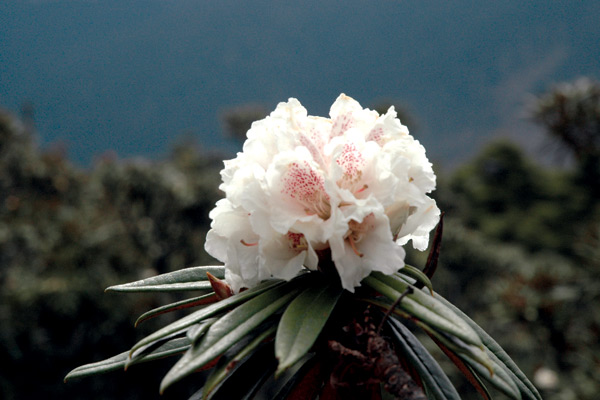
|
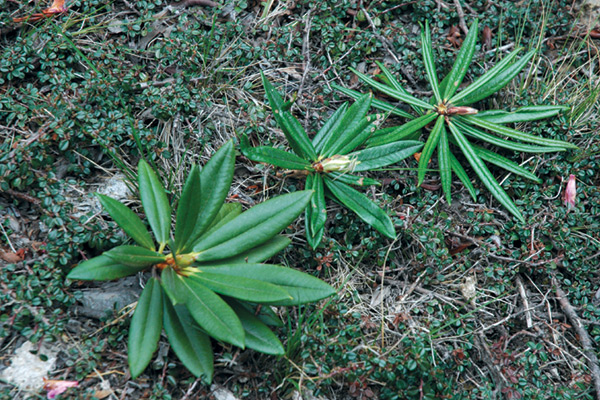
|
|
|
Plant of the Trip:
Rhododendron roxieanum
Photo by Garth Wedemire |
R. roxieanum
leaves showing variation within the species.
Photo by Garth Wedemire |
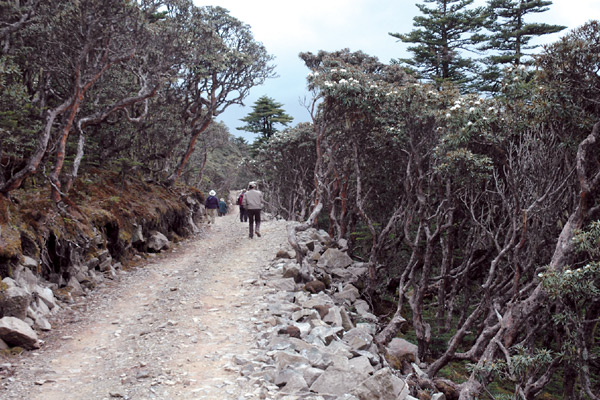
|
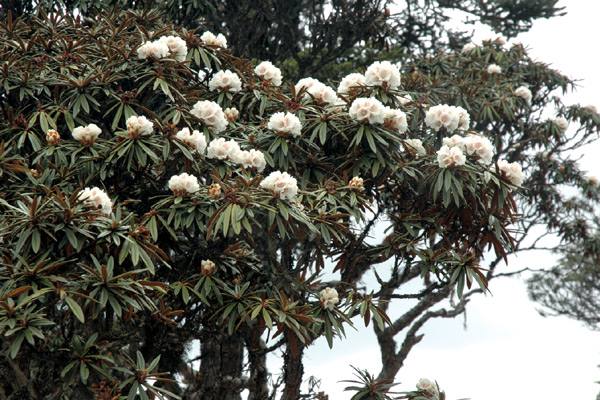
|
|
|
R. roxieanum
trees growing along road on way to Laojun Shan lodge.
Photo by Garth Wedemire |
R. roxieanum
treetop flowers.
Photo by Garth Wedemire |
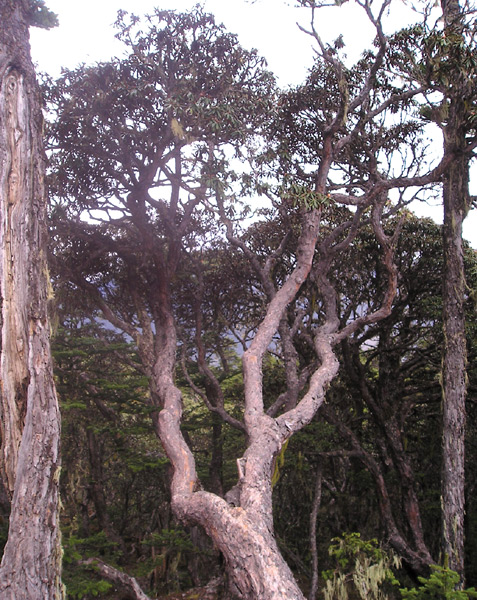
|
|
R. roxieanum
trunk.
Photo by Mary Berg |
Rhododendron lacteum
: Plant of the Day, May 19
Keith White
May 19th was our day to explore the famous Cang Shan. We had spent the night in Dali (Talifu), the famous ancient town of the Bai people and Nanzhao Kingdom that flourished until conquered by Kublai Khan in 1253. To get to the mountain road we drove past the majestic Dali San Ta (Three Pagodas Complex) that point towards the mountaintop. To find the road we had to thread our way through the maze of tracks around huge marble mining pits.
Once ascending the road we got further behind schedule because we couldn't resist stopping over and over again for the flora:
R. pachypodum
,
R. microphyton
,
R. virgatum
,
R. maddenii
ssp.
crassum
,
R. edgeworthii
,
R. trichocladum
,
R. neriiflorum
,
R. sulfureum
,
Vaccinium delavayi
, and
Arisaema
. There were also super views of Dali and adjacent huge Lake Erhai. Steve Hootman had to ride herd on us and the drivers or we would have never made it to the trailhead. The trailhead was rather inconspicuous. We drove right past and had to turn around. Once on it our first goal was the pagoda about 500 feet above us. At the pagoda there was a very nice blue
Abies delavayi
with candle-like red-brown cones. The view of the pagoda through the crags below and thoughts like these kept me rolling up the trail.
We were supposed to hike with a partner, but mine had given up some time back. I rather liked ambling on by myself, unaware of the time. Up above I heard voices. As I got closer I could tell that it was one of our group coaching Steve Hootman through dense brush towards some goal. The goal was a big
Rhododendron lacteum
that Steve climbed to pick a prime truss. The brush going back up was not a thrifty walk for Steve, so he bushwhacked his way down to the next lower trail rung on the series of switchbacks. We joined him there. His
lacteum
truss was a real prize. For our group this fine specimen made the Plant of the Day.
It was time to head down trail. Another group from above had joined us. They had made it to the snows where
R. campylogynum
and I believe
R. haematodes
were yet to bloom. They tried to console us that we hadn't missed much. I never believe such talk. It always best to see what's on top for yourself!

|
|
Rhododendron lacteum
: Plant of the Day, May 19.
Photo by Keith White |
Rhododendron sidereum
: Plant of the Day, May 20
Lori Bayes
As we climbed up the logging road above the Salween River we could see in the forest large masses of yellow on some of the trees. As we got nearer we could tell that these were sizeable (20-30 ft. [6-9m]) rhododendrons. At this point Steve confirmed what others had suggested: they were
Rhododendron sidereum
.
The effect of the 8-inch (20cm) trusses on the dark green foliage was very pleasing. In each truss there were 15-20 individual flowers, each bell-shaped, 8-lobed, yellow with crimson blotches. The long, narrow (up to 9 in. [23cm] in length and 3 in. [8cm] in width), dark green leaves with a silvery-white plastered indumentum were a good foil to the flowers above.
Never having seen
R. sidereum
in bloom I felt it to be quite a sight to observe in the wild. These spectacular trusses were one of my favorites. They are found in SW China (Yunnan) and NE Myanmar (Burma). They grow from 8,000-12,000 feet (2400m-3600m) in a temperate mixed forest.
Rhododendron sidereum
is still fairly rare in cultivation.

|
|
Rhododendron sidereum
: Plant of the Day, May 20.
Photo by Lori Bayes |
Rhododendron basilicum
: Plant of the Day, May 21
Bill McMillan
We first saw
Rhododendron basilicum
May 21st on a ridge above Hpimaw Pass near the border with Myanmar (Burma) in Yunnan Province northwest of the city of Liuku on the Salween River. Getting there involved several hours of travel by road that was generally good, often cobblestone, but had several collapsed and washed out areas. If one was nervous, there were places it was best not to be on the "cliff side" of the bus! Once we reached the pass, we hiked northward up the steep razorback ridge through a thick cover of bamboo and gaultheria. It was like walking through one of our salal thickets! Luckily, a local hunter or gatherer had been there shortly before us and hacked a crude trail through the dense bush. Although often we felt it with our feet rather than seeing it, the trail was a godsend. Without it, many of us would not have been able to bushwhack our way up the ridge, especially since the light to dense clouds whipping through the pass limited visibility and made keeping the group in contact difficult.
Along the trail we encountered
Rhododendron mallotum
with its wonderful foliage and cinnamon-brown indumentum,
R. arizelum
, and
R. zaleucum
. Unfortunately, these were not blooming. Near the ridge crest, at about 10,800 feet (3200m), Steve located a trench, which was a World War II sentry post, and it led to a 20-foot (6m) high tree of
R. basilicum
in an understory with R. dichroanthum ssp.
scyphocalyx
. Steve, who found this locale during an earlier trip, managed to climb the
R. basilicum
and recover leaves and a nearly spent truss of cream colored flowers with a red blotch.
The obliquely campanulate, fleshy corolla has eight lobes and color generally varies from white to cream, although some forms are rose. Cox and Cox (1997) note that inflorescence varies from 15 to 25. The large obovate to oblanceolate leaves displayed winged, flattened, tapering petioles. The leaf upper surface was dark green and rugulose. According to Cox and Cox,
R. basilicum
may have a semi-persistent indumentum on the upper leaf surface, and the wooly, grayish-cream indumentum seen on the lower surface is apparently bistrate, although it looked plastered on the leaves I checked.
We next saw
R. basilicum
on Ziben Shan mountain. Although
R. sinogrande
at this elevation gave way as we hiked up to the ridge to
R. basilicum
on the ridge crests, many of the plants were actually
R. basilicum
-
R. sinogrande
hybrids.

|

|
|
|
Rhododendron basilicum
, top side of leaves: Plant of the Day, May 21.
Photo by Bill McMillan |
Rhododendron basilicum
, under side of leaves: Plant of the Day, May 21.
Photo by Bill McMillan |
Rhododendron pseudociliipes
: Plant of the Day, May 22
Garratt Richardson
After an invigorating and successful exploration at Hpimaw Pass and its western flank, we now walked down the road towards the Nu Jiang (Salween River) and Liuku, i.e., the eastern side of this portion of the Gaoligong Shan and Irrawaddy-Salween divide. At about 9,000 feet (2700m) and some distance from the road, a stunning specimen of
Rhododendron pseudociliipes
was seen in full flower growing in the crotch of an old snag. A branch was fearlessly procured (not by me) and laid by the roadside for all to admire and photograph. This Maddenia is single-flowered and flushed a light pink. George Forrest is credited with its first collection in 1919. The major re-introduction was in 2000 when Steve Hootman et al. collected it on the Ziben Shan (v.i.). The classification is confusing; the species has been allied with
R. supranubium
and
R. pachypodum
. Those of us with zonal denial should be able to grow it in our gardens here in the Pacific Northwest.

|

|
|
|
Rhododendron pseudociliipes
: Plant of the Day, May 22.
Photo by Garratt Richardson |
Rhododendron pseudociliipes
, flowers.
Photo by Garth Wedemire |
Rhododendron nuttallii
: Plant of the Day, May 23
Jeanine Smith
On May 23, we left Fugong to travel up the Gaoligong Shan on the west side of the Salween River. We were told that we were the first Westerners to go up this recently opened road through the Yaping Pass toward Burma. It was a beautiful day and at about 6,000 feet (1800m) we began finding many rhododendron species:
Rhododendron protistum
,
R. sinogrande
,
R. rubiginosum
,
R. anthosphaerum
, and
R. glischrum
all growing in magnificent forest of fir, hemlock, oaks, ferns, arisaema, cardiocrinum, clematis, and vaccinium. We stopped along a rushing stream to botanize and spotted the striking new growth of
R. nuttallii
(formerly
sino-nuttallii
). One of our Canadians, Sean Rafferty, scrambled down the bank to retrieve a branch so that we could take a closer look and photograph it. Although the flowers were over, I was struck by the spectacular effect of the amazing rose- red purplish new growth!
Rhododendron nuttallii
of subsection Maddenia has the largest leaves of any lepidote. Its heavily bullate leaves range up to 10 inches (25cm) long by 5 inches (12cm) wide. The immense fragrant flowers are 5 by 5 inches (12 x 12cm), white to tinged pink with a yellow throat. Although this Chinese form may be somewhat hardier than those found in India, Bhutan, and Tibet, it is still tender and would need winter protection below 25F (-4C).
Although a road washout and a snow bank near the top of the pass prevented our reaching the Burma border, we returned to Fugong feeling that it had been a very successful day!
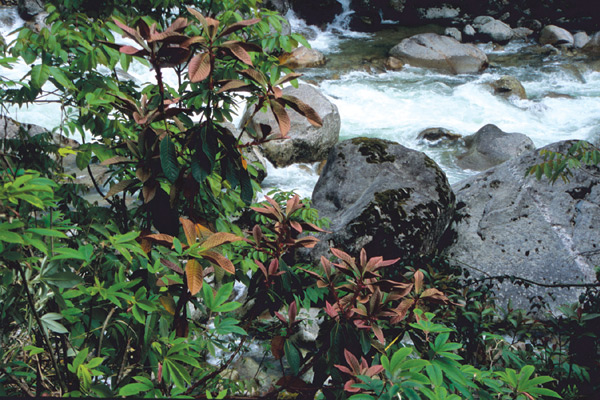
|
|
Rhododendron nuttallii
: Plant of the Day, May 23.
Photo by Jeanine Smith |
Trachycarpus princeps
: Plant of the Day, May 25
Garratt Richardson
Our plan was to drive south of Gongshan, cross to the east side of the Nu Jiang and drive up a very narrow and steep dirt road to explore some high elevation valleys. A hydroelectric dam was being built 15-20 miles up the road and further progress was impossible. We returned to Gongshan and were told that we could drive quite a ways up the Nu Jiang (Salween River). There were many changes since my visit in 2000. Several kilometers north of the last town Bing Zhong Luo, there were now several buildings, with a formal entranceway and ticket booth. We had a spectacular view of the first great bend of the Nu Jiang. The new road cuts through the bottom of crystalline limestone (aka marble) cliffs. These are over 1,000 feet (300m) high through which the river flows and have been fancifully named "the Stone Gate." There is now a viewing platform with picnic tables and restroom. One of our botanists, Wang, pointed out some palm trees, which were growing on these sheer cliffs. Although they had been seen, reported and misidentified in 1916, it was only in 1995 that these palms were recognized as a new species. The fascinating sleuthing story by Martin Gibbons, a Briton, and Tobias Spanner, a German, who were researching another palm via a Chinese text, is documented in the 1995 issue of the Journal of the International Palm Society. They were excited to discover this palm was not the one reported by early explorers. It is a windmill palm, in the genus
Trachycarpus
with a pure waxy-white underside of the leaf. The new species has been named
Trachycarpus princeps
(prince). Its hardiness is untested; the elevation is 5,000 feet (1500m). Online discussions reveal that it is being grown in British Columbia, Canada. Here in the northwest coast of North America,
Trachycarpus fortunei
is becoming increasingly popular for landscaping. I predict it won't be long before we see this beautiful specimen in our gardens.
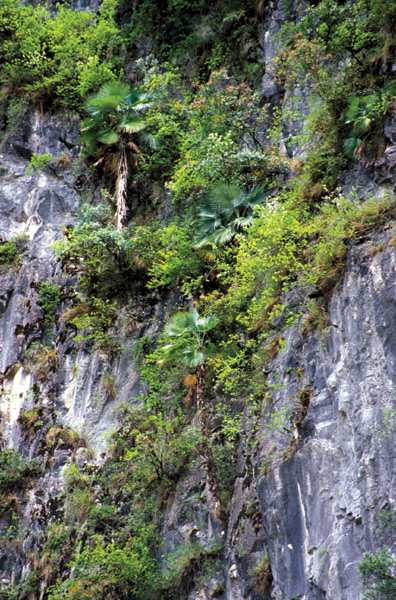
|
|
Trachycarpus princeps
: Plant of the Day, May 25.
Photo by Garratt Richardson |
Agapetes lacei
: (Second) Plant of the Day, May 25
Steve Hootman
Over the last several years I have come to admire the genus
Agapetes
, a group of mostly epiphytic (they grow upon other plants) evergreen shrubs closely related to the genus
Vaccinium
(blueberries, etc.). In lectures, I often refer to them as "flashy blueberries" because they usually have much larger and more colorful flowers than the blueberries and huckleberries. Indeed, they are essentially only differentiated from the blueberries by their long tubular flowers (blueberries have shorter urceolate or campanulate flowers). I have been collecting, growing and promoting
Agapetes
for years now and am always searching for new species and forms in their wild habitats.
One of my best finds occurred in the spring of 2005, as we drove north toward Tibet along the new road from Gongshan, following the course of the Salween River. At a photo stop, I found
Agapetes lacei
, a dwarf species with great foliage and large showy red flowers that I had lusted after and hunted for since I first saw an old dried specimen in the herbarium at the Royal Botanic Garden in Edinburgh years ago. Strangely enough, it showed up when I was least expecting it, on what was really just a touristy backup day due to a blocked road in the mountains. It was growing on rocks in the shade of a tiny bit of remnant forest next to a brand new parking area along the river. This small pull-off had recently been installed for viewing the famous white marble cliffs of the Salween River.
The tiny one-half inch (1.25cm) long pointed leaves were arranged in a flat plane along the long arching branches, no sign of flowers or fruit. It was very similar in appearance to the most commonly grown species in cultivationAgapetes serpens, but with shorter, more rounded leaves. The flowers are known to be bright red and tubular in shape, hanging from the long branches in earliest spring. The new growth, even in the deep shade, was bright pink fading to deep shiny green as one's eyes followed the stem back to the base. Several days later, I found the same species growing with
Rhododendron megacalyx
on a huge outcropping in the forest along the new road to the Dulong River. I was personally embarrassed since I had explored the very same outcropping five years earlier and had not noticed the (albeit small)
Agapetes
.
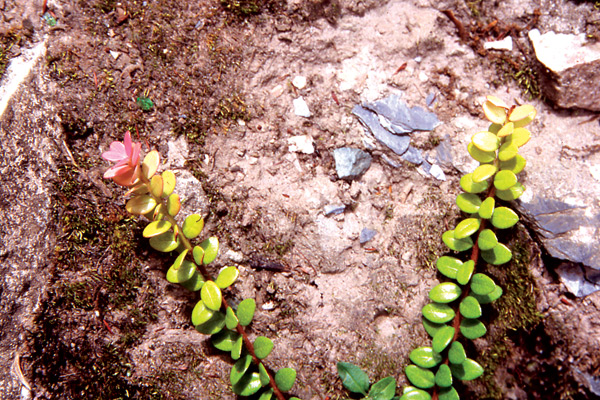
|
|
Agapetes lacei
: Plant of the Day, May 25.
Photo by Steve Hootman |
Rhododendron megacalyx
: Plant of the Day, May 26
Glen Jamieson
Rhododendron megacalyx
was discovered by Capt. F. Kingdom-Ward in 1914 at 8,000 feet (2400m) in Burma. It is a shrub or small tree, 5-10 feet (1.5-3m) tall, with brownish purple venation on its young leaves. It flowers from April to June, and its flowers are fragrant, white, with a 2.5-4 inch (6-10cm) corolla. On our trip to the Salween,
R. megacalyx
was one of the most impressive rhododendron species observed. We observed it a number of times in the Gongshan vicinity, but only were able to see it up close at one site on the road to the Dulong pass at an elevation of about 7,475 feet (2280m), where it was growing as a number of large plants out on a densely vegetated rock abutment about 33 feet (10m) above a fast-flowing stream. The road at the base of the abutment was cut into a cliff, and on the mossy cliff walls, numerous small seedlings, 1 to about 4 inches (3-10 cm) high, could be found. Other seedlings associated with this species on the cliff face were
R. edgeworthii
,
R. vaccinioides
,
R. dendricola
and
R. taggianum
.
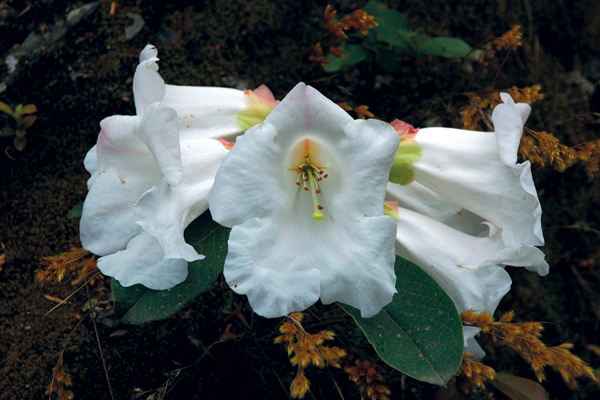
|
|
Rhododendron megacalyx
: Plant of the Day, May 26.
Photo by Glen Jamieson |
Schisandra
sp.: Plant of the Day, May 28
Loretta Goetsch
"
Schisandra
sp. is a large, hardy, deciduous vine with glossy pointed leaves and panicles of fragrant white flowers in spring on separate male and female plants. In early autumn the female plants, if pollinated, produce large clusters of red fruits. The leaves turn a brilliant yellow in autumn before falling off. It is easy to grow on a trellis in any average to rich garden soil in full sun." James Adams, Curator of the National Herb Garden, "Promising Plants Presentation," 2004. Our day of botanical exploring in Ziben Shan was special. We were transported up to an elevation of 10,500 feet (3200m) standing in the back of a lorry to a sunny meadow. The meadow was covered with
Rhododendron calostrotum
ssp.
calostrotum
, many in full bloom. The blooming Schisandra we saw on our walk down from the meadow had white flowers with varying amounts and intensity of pink. It was a new plant for many of us.
The Chinese name for Schisandra is Wu-wei-zi, meaning five taste fruit. The dried fruit is said to have sour, sweet, salty, hot and bitter taste. It is a used medicinally in China for a variety of medical conditions.
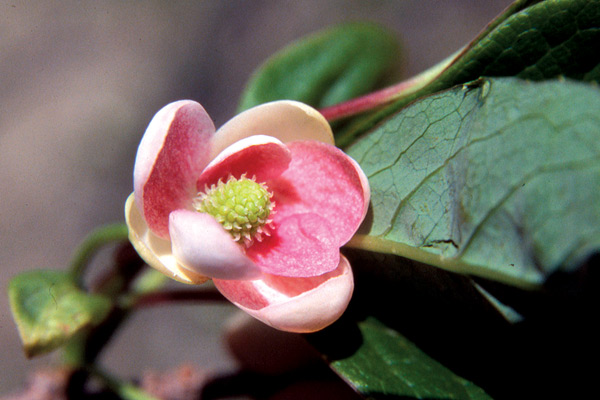
|
|
Schisandra
sp. Plant of the Day, May 28.
Photo by Keith White |
Rhododendron calostrotum
ssp.
calostrotum
: (Second) Plant of the Day, May 28
Garth Wedemire
The Rhododendron Species Foundation 2004 spring catalog's cover picture really caught my attention. It was a photograph taken by Steve Hootman of a meadow on the top of Ziben Shan in Yunnan, China. What a wonderful scene, a grassy meadow with plants of R. calostrotum ssp. calostrotum in the foreground with conifers on the tops of hills in the background. I wanted to see this place myself and to take similar pictures. I just had to get there! Fortunately, I was able to join an RSF trip to Yunnan in 2005.
Today was the day I had been waiting for on this Yunnan trip! We rose early in the morning in Caojian, had a quick breakfast and boarded our bus and jeeps to the starting point of the trip up the Ziben Shan. It was an absolutely clear and sunny day. The road up the Ziben Shan was so rough and steep that we had to leave our vehicles and hire a little high-bed orange truck and driver to transport us to the top.
What fun! Our group of seventeen eager plant explorers climbed up onto the back of the truck and hung on to hoops over our heads. We ducked branches and swayed in every direction as we bumped our way up the mountain.
After an hour or so, we were welcomed by a pastoral scene at the top of Ziben Shan. A few
R. calostrotum
plants were starting to bloom while horses and cows grazed throughout the meadow with the sound of a cuckoo in the distance. We turned around and were amazed to see the small hills on the southern side of the meadow colorfully ablaze. What a scene to behold - hillsides of
R. calostrotum
ssp.
calostrotum
in full bloom! We had a great time taking pictures and posing among the plants.
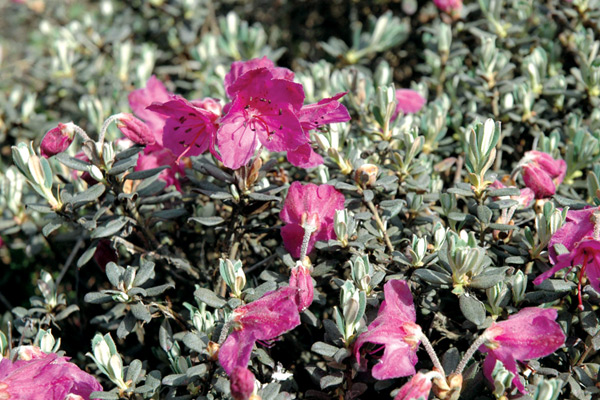
|
|
Rhododendron calostrotum
ssp.
calostrotum
: Plant of the Day, May 28.
Photo by Garth Wedemire |
Aeschynanthus tengchungensis
: Plant of the Day, May 29
Brenda Macdonald
Plant of the Day for May 29th was
Aeschynanthus tengchungensis
, which although a pretty enough plant in its own right, may well have won by default as one of the few blossoms we encountered that day. It had been a particularly frustrating day for the group, as we had been lead to believe that the road we were taking into the Baihualing Ecological Preserve could be driven to about 10,000 feet (3000m), after which we could hike up even further and maximize our chances of seeing some additional rhododendron species.
It was not to be. At about 6,500 feet (1900m) our vehicles were stopped by a significant washout. This was a not unfamiliar situation, but it was the realization that this washout had occurred a number of years earlier that changed our communal disappointment to communal frustration.
Nevertheless it was, as they say, a nice day for a walk in the forest, and although the instances of rhodo species in blossom were basically none, we did see a few hydrangeas, some magnificent ferns, a glimpse of the elusive golden leycesteria (
Leycesteria crocothyrsos
) originally documented by Kingdon-Ward, and, as a series of bright red arcs hanging down from its epiphytic perch, the
Aeschynanthus
.
A member of the huge Gesneriad family whose other members include African violets and
Streptocarpus
, the genus
Aeschynanthus
contains many houseplants grown under the common name of lipstick plant.
Its botanical name is derived from the Greek roots "aeschyn" meaning "causing shame" and "anthus" meaning "flower." The proffered explanation that it was the bright red blossom colour of many of the species in this genus that had inspired the association with shame seemed pretty tenuous, but who am I to plumb the depths of a botanist's psyche.
It was only after discovering the other significant characteristic of this genus, that the flowers are "protandrous," did it occur to me that I might be reading the "suitable for family viewing" version of the derivation. For it seems that a protandrous organism is a sequential hermaphrodite - a factor I would have thought far more cause for concern than the colour red. Of course, in a botanical context, a protandrous flower is simply one in which the stamens and anthers develop, disperse their pollen, and then start to wither before the stigma is mature enough to accept fertilization. This adaptive growth pattern minimizes the chances of self-pollination for each individual flower, thus increasing gene pool mixing and maintaining species vigour.
And certainly, shameful or not, the scarlet, waxy, tubular flowers glowing in the patchy sunlight of the green forest well deserved the designation of Plant of the Day.
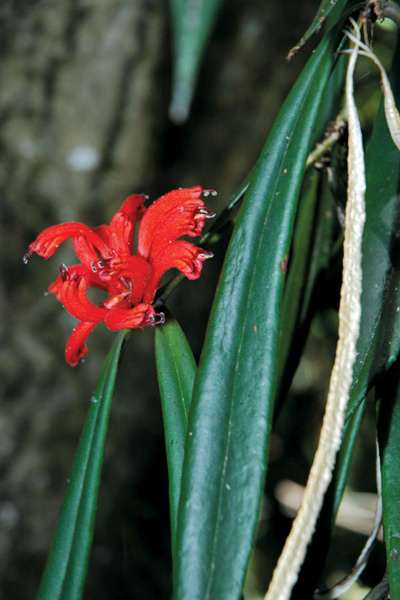
|
|
Aeschynanthus tengchungensis
: Plant of the Day, May 29.
Photo by Glen Jamieson |
OTHER NOTEWORTHY PLANTS
Coelogyne ochracea
Glen Jamieson
Coelogyne ochracea
was observed twice on the Yaping Pass where we found it growing on the mossy, shaded trunks of live trees 6-13 feet (2-4m) above the ground. Observed plants of this orchid were relatively small, about 2-3 inches (5-7cm) high, but had relatively large, dramatic 1 inch (3cm) white flowers, each with a red-lined yellow blotch in its throat. It was found with large
Rhododendron sinogrande
(some in excess of 65 ft. [20m] high), the giant Yunnan lily
Cardiocrinum giganteum
and
Clematis montana
var.
grandiflora
, all of which can now be found in regional northwest gardens. In the shaded light of the lower canopy, the clematis and orchid stood out impressively because of their pure white colouration.
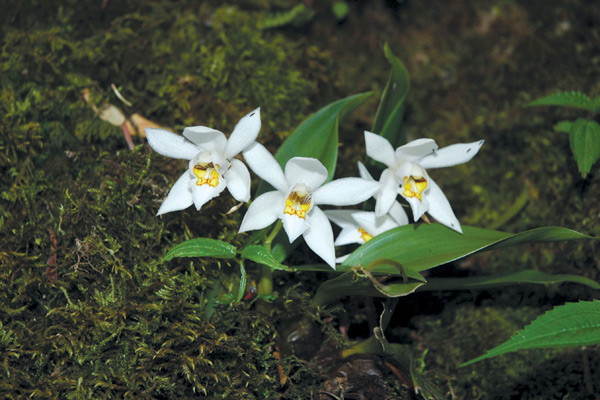
|
|
Coelogyne ochracea
Photo by Glen Jamieson |
Primula forrestii
Dalen Bayes
It was with delight that I saw clumps of bright yellow flowers sitting atop 6-inch (15cm) stems surrounded by dark green foliage. We had just reached the crest of a 9,000-foot (2700m) ridge in the Yulong Xue Shan, and before me lay
Primula forrestii
, my first primula of our trip. It was first discovered by George Forrest in this area and introduced by him into western civilization a century ago.
Primula forrestii
is a robust woody-based plant that can form long stemmed tussocks. Its leaves are dark green with small rounded teeth and a revolute margin. The flowers are golden yellow with an orange eye, flat-faced and up to an inch (2.5cm) in diameter. Framed by the dark foliage they present a most beautiful sight. They seemed out of place among the limestone rocks and dry soil, exposed to the full sun. Although they had received little moisture in the previous eight months, they would soon be drenched by the coming monsoon.
In cultivation they like a very well drained soil, full sun and some lime. In most of the year they prefer to be quite dry with some water in the summer. They are said to be very long-lived. Mine died in one wet winter.
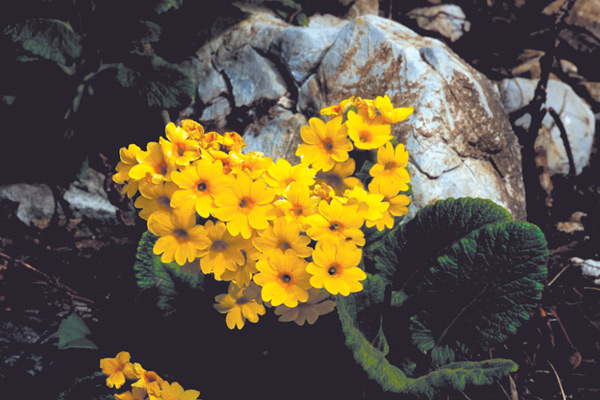
|
|
Primula forrestii
Photo by Dalen Bayes |
Rhododendron sinogrande
Steve Hootman
Rhododendron sinogrande
is well known for having the largest leaves of any species in the genus, up to 3 feet (1m) long on young vigorous specimens. It is a common species in the mountainous forests along both banks of the Salween River along the western Yunnan frontier with Myanmar (Burma). Here it typically forms a common or even dominant understory species beneath giant evergreen oaks and hemlocks. Large specimens can reach up to 70 feet (21m) in height although it is typically much shorter than this. During a six-week expedition to this region in the spring of 2000, we noted what had been a fantastic amount of bloom on this species in virtually every location we visited. Unfortunately, we were a little too late and could only marvel at the spent blossoms covering the large statuesque specimens.
With another opportunity in the spring of 2005, I arranged to visit these locations a bit earlier in the season, hoping to witness one of the grandest displays in the world of rhododendrons. Alas, the season was even earlier than in 2000 and I once again missed seeing this most magnificent of species in its full glorious display.
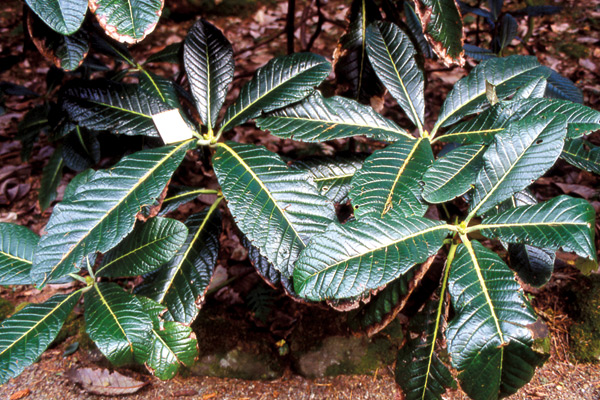
|
|
Rhododendron sinogrande
Photo by Steve Hootman |
Rhododendron edgeworthii
Keith White
Ubiquitous, but not to be taken for granted. That is a good phrase for
Rhododendron edgeworthii
. A very successful epiphytic lepidote, we found
edgeworthii
growing in trees and on rocks at almost every locale we investigated.
Rhododendron edgeworthii
ranges west to Nepal, east to Yunnan and Sichuan. It is found in Sikkim, Bhutan, Assam and SE Tibet.
Rhododendron edgeworthii
is remarkably fragrant. The flowers are a beautiful white, often tinged with shades of pink. The leaves are bullate and thickly indumented. It is rangy in habit and not for those fanciers who prefer tight little buns for their plants.
Rhododendron edgeworthii
is semi-hardy in the Pacific Northwest. It tolerates outside temperatures as low as 15 F (-9C) and it will grow in the ground as long as it has excellent drainage. A perfect place is a pot, since it does well with restricted root space, typical of epiphytes. This also affords good drainage. A pot also allows it to be taken into the garage when the weather is really cold.
We decided that although
R. edgeworthii
was not the Plant of the Day on any specific day, it certainly was one of the outstanding plants of the trip. You will be happy if you try it.
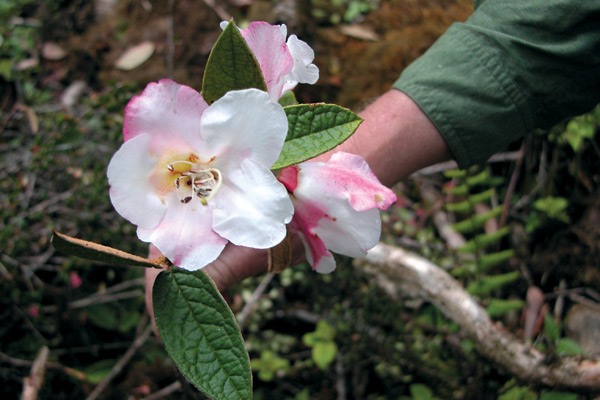
|
|
Rhododendron edgeworthii
Photo by Bill McMillan |